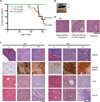Smurf2 regulates the senescence response and suppresses tumorigenesis in mice
- PMID: 22552287
- PMCID: PMC3616636
- DOI: 10.1158/0008-5472.CAN-11-3773
Smurf2 regulates the senescence response and suppresses tumorigenesis in mice
Abstract
The E3 ubiquitin ligase Smurf2 mediates ubiquitination and degradation of several protein targets involved in tumorigenesis and induces senescence in human cells. However, the functional role of Smurf2 in tumorigenesis has not been fully evaluated. In this study, we generated a mouse model of Smurf2 deficiency to characterize the function of this E3 ligase in tumorigenesis. Smurf2 deficiency attenuated p16 expression and impaired the senescence response of primary mouse embryonic fibroblasts. In support of a functional role in controlling cancer, Smurf2 deficiency increased the susceptibility of mice to spontaneous tumorigenesis, most notably B-cell lymphoma. At a premalignant stage of tumorigenesis, we documented a defective senescence response in the spleens of Smurf2-deficient mice, consistent with a mechanistic link between impaired senescence regulation and increased tumorigenesis. Taken together, our findings offer the genetic evidence of an important tumor suppressor function for Smurf2.
©2012 AACR
Conflict of interest statement
Figures




Similar articles
-
Smurf2-mediated ubiquitination and degradation of Id1 regulates p16 expression during senescence.Aging Cell. 2011 Dec;10(6):1038-46. doi: 10.1111/j.1474-9726.2011.00746.x. Epub 2011 Oct 7. Aging Cell. 2011. PMID: 21933340 Free PMC article.
-
Suppression of human tumor cell proliferation by Smurf2-induced senescence.J Cell Physiol. 2008 Jun;215(3):613-20. doi: 10.1002/jcp.21337. J Cell Physiol. 2008. PMID: 18181147
-
Smurf2 regulates hematopoietic stem cell self-renewal and aging.Aging Cell. 2014 Jun;13(3):478-86. doi: 10.1111/acel.12195. Epub 2014 Feb 4. Aging Cell. 2014. PMID: 24494704 Free PMC article.
-
Spotlight on the role of COP1 in tumorigenesis.Nat Rev Cancer. 2012 Jun 7;12(7):455-64. doi: 10.1038/nrc3271. Nat Rev Cancer. 2012. PMID: 22673153 Review.
-
The functions and regulation of Smurfs in cancers.Semin Cancer Biol. 2020 Dec;67(Pt 2):102-116. doi: 10.1016/j.semcancer.2019.12.023. Epub 2019 Dec 30. Semin Cancer Biol. 2020. PMID: 31899247 Review.
Cited by
-
Smurf2 suppresses B-cell proliferation and lymphomagenesis by mediating ubiquitination and degradation of YY1.Nat Commun. 2013;4:2598. doi: 10.1038/ncomms3598. Nat Commun. 2013. PMID: 24121673 Free PMC article.
-
Skeletal Characterization of Smurf2-Deficient Mice and In Vitro Analysis of Smurf2-Deficient Chondrocytes.PLoS One. 2016 Jan 27;11(1):e0148088. doi: 10.1371/journal.pone.0148088. eCollection 2016. PLoS One. 2016. PMID: 26815610 Free PMC article.
-
Quercetin-induced degradation of RhoC suppresses hepatocellular carcinoma invasion and metastasis.Cancer Med. 2024 Feb;13(4):e7082. doi: 10.1002/cam4.7082. Cancer Med. 2024. PMID: 38457248 Free PMC article.
-
Smurfs in Protein Homeostasis, Signaling, and Cancer.Front Oncol. 2018 Aug 2;8:295. doi: 10.3389/fonc.2018.00295. eCollection 2018. Front Oncol. 2018. PMID: 30116722 Free PMC article. Review.
-
Downregulation of Smurf2, a tumor-suppressive ubiquitin ligase, in triple-negative breast cancers: involvement of the RB-microRNA axis.BMC Cancer. 2014 Feb 3;14:57. doi: 10.1186/1471-2407-14-57. BMC Cancer. 2014. PMID: 24485087 Free PMC article.
References
-
- Kavsak P, Rasmussen RK, Causing CG, Bonni S, Zhu H, Thomsen GH, Wrana JL. Smad7 binds to Smurf2 to form an E3 ubiquitin ligase that targets the TGF beta receptor for degradation. Mol Cell. 2000;6:1365–1375. - PubMed
-
- Lin X, Liang M, Feng XH. Smurf2 is a ubiquitin E3 ligase mediating proteasome-dependent degradation of Smad2 in transforming growth factor-beta signaling. J Biol Chem. 2000;275:36818–36822. - PubMed
-
- Han G, Li AG, Liang YY, Owens P, He W, Lu S, Yoshimatsu Y, Wang D, Ten Dijke P, Lin X, Wang XJ. Smad7-induced beta-catenin degradation alters epidermal appendage development. Dev Cell. 2006;11:301–312. - PubMed
Publication types
MeSH terms
Substances
Grants and funding
LinkOut - more resources
Full Text Sources
Other Literature Sources
Medical
Molecular Biology Databases

